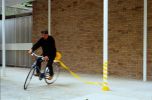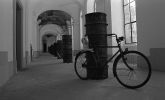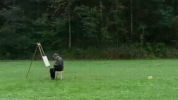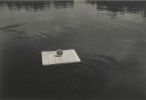For the ambit of the convent, Roman Signer created a sculpture in time, a bicycle work and a combination of oil barrels and yellow ribbon. He drove around the columns made of empty barrels, marking the trajectory with a line of plastic yellow ribbon, attached on the back of his bicycle.
Yellow Ribbon is the bicycle work that Signer had created in 1982 for the then derelict Kunstmuseum St. Gallen. He rode around two monumental pillars several times, whereby a yellow plastic ribbon, a roll of which was attached to his bicycle rack, unwound and wrapped itself around the pillars, marking the path just taken. Movement in space thus becomes visible and materializes as spatial structure, as sculpture. Two years later, the artist expanded this conception for an exhibition at the Städtische Bodensee-Museum Friedrichshaven by unwinding a ribbon from a bicycle circling around four pillars, thereby fencing off a square of space. The bicycle leaned against a pillar at the conclusion of the process and the ribbon wrapped several times around the columns, enabling the course of action to be reconstructed. Roman Signer repeated this basic setup in the courtyard of the Swiss Pavilion: Bicycle (1982/1999) in Venetia. This time, he mounted his bike, and circled only around one single pillar. The riding movement is thus made visible, but becomes fixated at one point to a three-dimensional image of complete immobility. The dynamics of the process are even more clearly suspended in the static concentration of a compact object, producing an impression of senselessness whose meaning lies exactly in the unbridgeable contradiction. This basic setup between the dynamic and the static evolves into that singular quality of the absurd that is so characteristic of Roman Signer's work.
The work was supported by Pro Helvetia and Martina Tomášková (bike), ČEPRO a.s. (barrels), Aeroklub Plasy (transport).
Roman Signer (born 1938 in Appenzell, Switzerland) studied at the Schule für Gestaltung in Zurich and Lucerne between 1966 and 1971. He studied at the Academy of Fine Arts in Warsaw, Poland from 1971-72. Signer started his career as an artist later in life at the age of 28, after working as an architect’s draughtsman, a radio engineer apprentice, and working a short stint in a pressure cooker factory.
Signer's work has grown out of, and has affinities with both land art and performance art, but his works are not typically representative of either category. They are often described as following the tradition of the Swiss engineer-artists, such as Jean Tinguely and Peter Fischli & David Weiss. Signer’s "action sculptures" involve setting up, carrying out, and recording "experiments" or events that bear aesthetic results. Day-to-day objects, such as umbrellas, tables, boots, containers, hats and bicycles, become part of Signer’s working vocabulary. Following carefully planned and strictly executed and documented procedures, the artist enacts and records such acts as explosions, collisions, and the projection of objects through space. Signer advocates "controlled destruction, not destruction for its own sake." His work gives a humorous twist to the concept of cause and effect and to the traditional scientific method of experimentation and discovery, taking on the self-evident nature of scientific logic as an artistic challenge.





